
Beyerdynamic DT 880 headphones
Review date: 8 Jun 2004.Last modified 03-Dec-2011.
Headphones are to speakers as motorcycles are to automobiles. Not as generally useful, sure, but significantly better in some respects. And a whole lot cheaper for a given level of performance.
A really top-flight supercar costs more than most people would countenance paying for a house. But you can get a super-cycle that can out-accelerate almost any street-legal car - and a lot of racing cars - for the price of a basic family sedan.
And so it is with headphones. People routinely buy very ordinary speakers for the price of some of the finest headphones in the world. If you've just got to have floorboard-moving bass or the ability to play to everyone in the room at once then there's no way to go but loudspeakers. But a lot of people who buy speakers, especially for computers, would do well to seriously consider headphones instead.
Like these, for instance. They're Beyerdynamic's current model DT 880s - there's been a Beyer DT 880 before, back in the late 1980s, but it was quite different.
Here in Australia, Aus PC Market sell the DT 880s for $AU499.40, including delivery anywhere in the country.
[Or they did, anyway. It's been a couple of years now, and they don't stock these headphones any more. They've dropped their price on the DT 860s, though.]
Buy your 880s from a reputable dealer in the States and you'll pay something in the order of $US260, ex delivery. That's only a mere $AU375 or so, as I write this, but Aussies considering importing a pair to save some money should note that unless their parcel whistles through Customs without attracting GST, there's not a lot of point. You might save $AU50 if you're lucky, but shipping will probably cost enough that you won't even save that much. You'll see why in a moment.
Now, $AU500-odd is an easy 20 times the price of a really cheap (and probably really nasty) pair of headphones. It's five times the price of what most people would consider a pretty decent set of cans (man). But it's still not that much money.
In geek terms, right now, $AU500 is about the price of a couple of 200Gb hard drives. Or a 3.2GHz Pentium 4C. Or a really good 1Gb DDR memory module.
Nerds buy that kind of stuff every day, glum in the knowledge that it'll depreciate about as fast as ham. Drop the same dollars on a really nice pair of headphones and, most likely, you'll still be delighted by those same headphones when today's $250 hard drive has long since become a magnet donor.
It's possible to spend really outrageous amounts of money on headphones, if you try. As is the case for most other hi-fi components, the sky's the limit for those who will settle for nothing less than the very finest carved-from-mahogany, driven-by-valves, caressed-by-the-Dalai-Lama hardware.
Among music lovers blessed with more sense than money, though, it is generally accepted that the DT 880s are serious contenders for World's Best Headphones.
I don't want to spoil the surprise, or anything, but yes, they're worth the money.
What you get
In my opinion, the first question you should ask about any pair of full-sized headphones is whether they're comfortable or not. If they aren't, then they fall at the first hurdle. Never mind how nice they sound, or how cheap they are. If you don't expect to have to wear the 'phones for very long each day then comfort is, I suppose, less important. But it's a biggie for me.
Smaller headphones meant for portable use have to clamp your head, hook your ears or invade your ear canals - maybe all three at once - so they don't fall off when you move. Portable 'phones also have to be pretty small, because it is generally agreed that people who wear full-sized headphones in public look like total steaming schnooks.
So there's no way for portable 'phones to sit gently around your ears, which is what headphones have to do to in order to be really comfortable.
The DT 880 earpads, however, look like this. They're highly strokable silvery velvet, with an outside diameter of about 10cm (four inches), and they do not clamp your head terribly much.
I was afraid that they would when I first looked at these headphones, because there's enough spring in the headband that the two earpads naturally press against each other. I had to hook one behind the other to take this picture. But, I'm happy to say, the DT 880s don't actually squish you very hard, and it's possible to bend the band back to make them looser.
My own good-but-not-great Sennheiser HD 590s are much less head-clampy than the DT 880s in un-adjusted trim, but the Beyers are definitely acceptable for extended wear.
They're not terribly heavy, either. There's more than a little metal in the Beyers, but they still only weigh about 270 grams (9.5 ounces) sans cable. Include the whole length of the curly cord (it won't all, of course, usually be hanging from your head) and you're up to about 336 grams (11.9 oz).
That's fine, but it's not feather-light. The HD 590s were an early example of Sennheiser's current surprisingly light almost-all-plastic designs; they only weigh 214 grams (7.5 oz), without cable. Their standard three metre cord only adds another 33 grams (1.2 oz).
You won't find full-sized headphones much lighter than that anywhere, but the Beyers are less than a hundred grams heavier, which really doesn't matter. Human brains generally weigh at least 1300 grams, and most people manage to carry that around without too much trouble.
The metal I mentioned above isn't just the aluminium of the earpiece frames; there's also some steel.
Here it is, revealed by the somewhat retro press-stud-retained removable headband padding. This spring steel is the explanation for the taut-yet-forgiving headband, and it's also why you can unbend the headband if you want a looser fit.
Why will a pair of DT 880s cost a fair bit of money to ship internationally?
Because of this.
This box is made of aluminium, and it's about 12 by 22 by 28 centimetres (4.7 by 8.7 by 11 inches) in size. I think it pretty much guarantees that your DT 880s will reach you in pristine condition, but once you take the headphones out of it you could build a frickin' computer in the space that's left. Or hang onto the box and use it to keep your precious new babies safe from harm, of course.
You don't get a manual with the DT 880s. You do get a warranty card, but that didn't look very exciting so I left it out of this picture. You also get an extension cable, and a 1/4 inch adapter for the end of the headphones' own cable, which terminates in a 1/8th inch plug, as is normal these days.
The extension cable is necessary because the headphones' own old-school extensible curly cord only stretches to three metres - and it's not as if you're going to stretch the thing, twanging, across your listening room. It's only about a metre long, unstretched. The extension cord isn't curly; it's five metres long.
(Unlike many true old school headphones, these ones have a cable connection on only one side. That's a definite convenience feature.)
The 1/4 inch adapter, by the way, screws in to the end of the main headphone cable. If you lose it, though, you can use a regular friction-fit adapter plug instead.
Turning it up
The first thing I noticed when I plugged the DT 880s in is that they didn't play very loudly, compared with my HD 590s. The reason for that is that the Beyers have a nominal impedance of 250 ohms, versus 120 ohms for the Sennheisers.
Headphones (or speakers) with a very low impedance can be "difficult to drive"; if their impedance is particularly low for particular input frequencies, the amplifier driving them can run out of current capacity even at quite low volume levels, resulting in distortion.
High impedance loads like these Beyers are not "difficult". Anything can drive 'em. The problem is that instead of gasping to deliver enough current, the driving amplifier may not be able to deliver enough voltage to get sufficient volume out of the transducers. If you only want to listen quietly, you'll be fine, but if you want to ask Mr Sulu how fast this crate can go, the answer may be "not very".
Fortunately, 250 ohms is not a terribly high impedance, and the Beyers are decently sensitive - they produce a pretty good amount of sound per milliwatt of power. The result of this is that while they're likely to be quite unsuitable for use with many portable audio devices - unless you add an extra portable headphone amplifier - they ought to be loud enough for most people's purposes from pretty much any mains-powered audio hardware.
As I've discussed in my reviews of headphone amps before (here and here), there's good reason to buy at least a basic headphone amp to go with virtually any piece of audio hardware, if you're serious about your headphone listening. If you're using high-ish-impedance headphones like the DT 880s, then you'll probably want an amp capable of pretty high output voltage, too.
My BitHead amp couldn't push the DT 880s into even the lower range of the oh-so-entertaining headache range of volumes even when it was running from battery power - which gives it a six volt power supply, instead of the five volts it gets from its USB cable. The little CMoy, though, was more than up to the task. It made clear to me that, if fed enough volts, the stately DT 880s are perfectly happy to break traction and scare the neighbours.
Back in the land of gear-most-people-have, the DT 880s also ran at quite acceptable volume for everyday listening straight from the back panel output of my PC motherboard. I think the Beyers actually made the PC's undistinguished headphone output sound a bit better than it did through lower impedance 'phones; the Beyers' higher impedance is kinder to the underpowered mobo audio hardware.
There are quite a few models of high end headphones with much higher impedance than the DT 880s. 600 ohm 'phones aren't hard to find. Those, unless they're quite remarkably efficient, really can't be used without an outboard amplifier, if you want more than very modest volume. The DT 880s sneak under the bar, though. They'll do.
Listening
What do the DT 880s sound like?
They don't sound like anything.
Headphones shouldn't sound like something. They shouldn't add anything to what you're listening to through them. And these ones don't.
Well, not that I can notice, anyway. Owners of more experienced - or possibly just pretentious - ears than mine may opine that "Although the [Sennheiser] HD 600 might image a bit better and seem a little more coherent, the Beyers are a bit more intimate and less laid-back", but I shall refrain from similar pronouncements.
I rolled through my usual collection of Audiophile Wank Tracks in my listening tests, and the 880s were, well, flawless. They stayed comfortable, they sounded as transparent as any headphones I've heard; actually, the only problem I struck was that the chunky Beyer cable dangling from the BitHead stuck to the side of my desk put more strain on the plug and socket than I would have liked. But just flopping the curly cord across my lap cured that, and if I were going to commit to a long term relationship with these 'phones then I'd just relocate the amp.
I wasn't about to splat my Recommended stamp on the 880s without actually listening to them for a goodly while, though, so I figured I might as well feed 'em weird stuff and see if anything untoward happened.
Reggae Floyd, Big Apple stream of consciousness, 45 hits in 65 minutes, chicka-wow chicka-wow wow, banjo Bach...
Nope. No problems. All nice. And not, despite my cars-and-bikes analogy, at all like the white-knuckle experience of driving a high-performance machine. Only occasionally did the sheer performance of the Beyers jump up and grab my attention. The rest of the time, they just disappeared.
The DT 880s are, by the way, described as "semi open" headphones; they're meant to be a cross between sealed-to-your-head closed 'phones and grillework-on-both-sides open ones.
Well, they're a lot more open than they are closed, if you ask me. Plenty of sound leaks out of the grilles on the outside of the ear cups (listen loudly and the person in the next cubicle will have no choice but to listen too...), and plenty of outside noise can get in (so you'll hear your workmate complaining).
The Beyers do have noticeably better isolation than very-very-open 'phones like my HD 590s, though. It's not nearly the goodbye-outside-world muffling of true closed 'phones, but it's enough to somewhat pleasingly reduce the intrusiveness of outside sounds. Consider it a small bonus.
Overall
So - I like 'em. I like 'em a lot. And not least because these headphones look the way headphones are supposed to look. No streamlined, shiny, encapsulated, all-plastic design, all clipped and glued together and made durable by advanced materials. Aluminium, old-fashioned hard plastic, press-studs, rubber, exposed wires. And that good old curly cord. Yeah.
Are the DT 880s the best headphones in the world? Heck, I don't know. But, pending the installation of a direct line-in to the brain's audio centres, high end headphones like these are the best sound-to-consciousness interface you're going to find, unless you feel like spending Big Bucks on speakers that'll probably have to be delivered by piano movers.
The DT 880s aren't hideously expensive, for what you get. They're comfy. And they should also play acceptably loudly when plugged into any non-portable sound source. If you must use 'em with an MP3 player lacking in the output voltage department, you can always grab yourself a little amp to go with it.
If you want Star Trek styling, these aren't the headphones for you. And if you're shepherding your pennies, it's not hard to find headphones that cost half as much as the DT 880s, and certainly aren't only half as good.
But I'd buy 'em. Highly recommended.
Buy stuff!
Aus PC Market don't sell the DT 880s any more. They have many
other headphones, though - and the
DT 860s are going cheap these days.
(if you're not in Australia or New Zealand,
Aus PC Market won't deliver to you. If you're in the USA, try a price search
at
DealTime!)
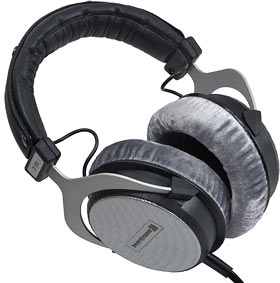
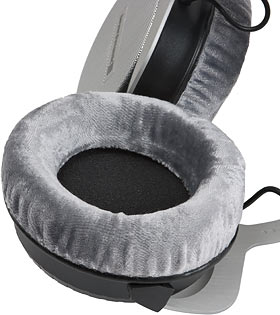
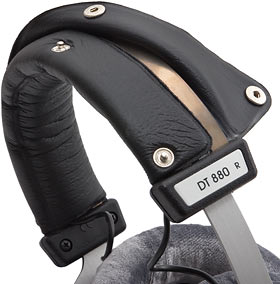
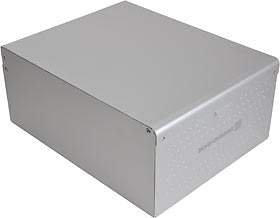

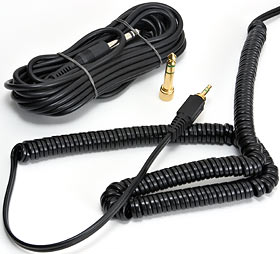

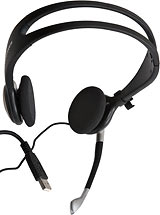

![[SecureWebs]](images/sw.gif)